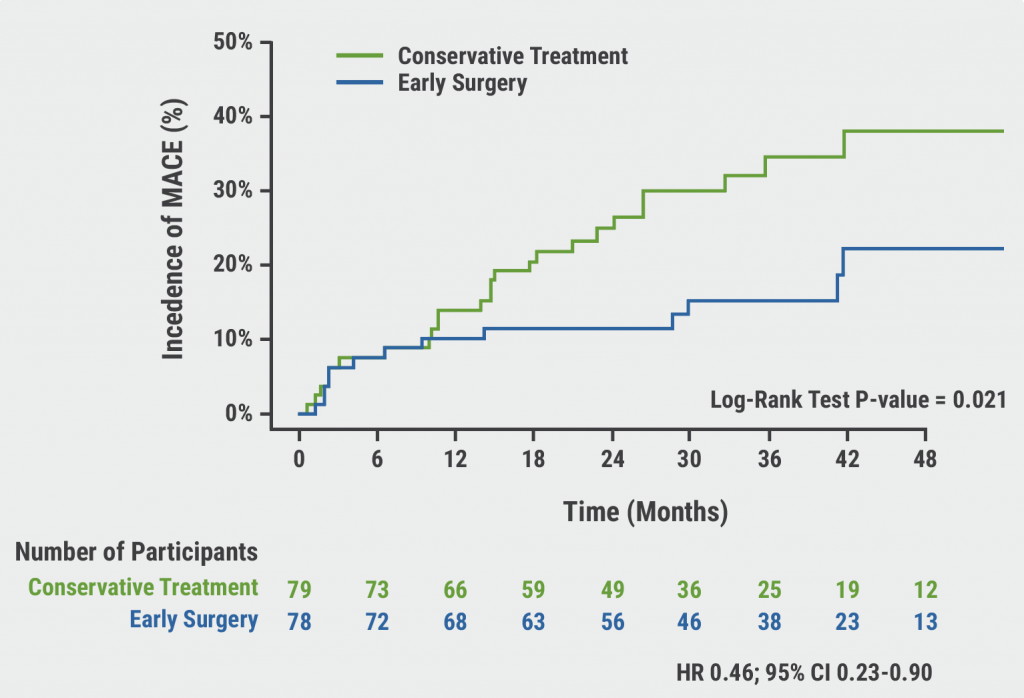“It is common to perform tricuspid repair during MVS in patients with mitral regurgitation and severe TR. However, there is a large variability in clinical practice regarding the threshold for performing surgery in patients with mild or moderate tricuspid regurgitation,” argued Prof. James Gammie (University of Maryland, MD, USA) [1]. Thus, the current trial investigated concomitant, undersized, rigid, non-planar tricuspid annuloplasty during MVS in patients with less than severe tricuspid regurgitation. Participants were randomised 1:1 to MVS alone (n=203) or MVS plus tricuspid annuloplasty (n=198). The primary endpoint was treatment failure at 2 years, defined as the composite of death, re-operation for tricuspid regurgitation, or tricuspid regurgitation progression from baseline.
At 2 years, treatment failure was reduced in the MVS plus tricuspid annuloplasty arm (3.9%) compared with the MVS alone arm (10.2%; RR 0.37; P=0.02). Subgroup analysis revealed that the difference in treatment failure between surgery groups was more pronounced in patients with moderate tricuspid regurgitation (18.1% vs 4.5%; RR 0.25; 95% CI 0.07–0.83) than in patients with less than moderate tricuspid regurgitation (6.1% vs 3.4%; RR 0.56; 95% CI 0.17–1.87). In addition, the effect was driven by tricuspid regurgitation progression from baseline and not by death or re-operation for tricuspid regurgitation. The proportion of participants with moderate or severe tricuspid regurgitation after 2 years of follow-up was higher in the MVS group (25.1%) than in the MVS plus tricuspid annuloplasty group (3.4%; RR 0.13; 95% CI 0.06-0.30). Notably, the risk of permanent pacemaker implantation was increased in the MVS plus tricuspid annuloplasty arm (14.1%) versus the MVS alone arm (2.5%). No difference was observed in all-cause mortality, quality of life, or major adverse cardiovascular or cerebrovascular events (MACCE).
Dr Gammie added that the 2-year endpoint may be too short to determine the long-term effects of tricuspid annuloplasty in this population. Thus, long-term follow-up is being performed to weigh the clinical benefits of this procedure against the cost of an increased risk of permanent pacemaker implantation.
- Gammie JS, et al. Evaluating the benefit of concomitant tricuspid repair during mitral valve surgery. LBS01, AHA Scientific Session 2021, 13–15 November.
Copyright ©2021 Medicom Medical Publishers
Posted on
Previous Article
« Blood pressure control disrupted during the pandemic Next Article
Accurate ejection fraction assessment in paediatric patients via artificial intelligence »
« Blood pressure control disrupted during the pandemic Next Article
Accurate ejection fraction assessment in paediatric patients via artificial intelligence »
Table of Contents: AHA 2021
Featured articles
The scope of remote healthcare in hypertension and hyperlipidaemia
Atrial Fibrillation
New developments in remote diagnostics and monitoring of AF
Head-to-head: Efficacy of dabigatran versus warfarin on cognitive impairment
Posterior left pericardiotomy safe and effective in reducing atrial fibrillation
LAA ligation did not reduce recurrent atrial arrhythmias in persistent AF
Equal benefits of early rhythm control in AF subtypes
CVD Risk Reduction
Remote healthcare programme improves hypertension and lipid control
Novel oral PCSK9 inhibitor shows promising results for hypercholesterolaemia
REVERSE-IT: Interim analysis shows promising effect of bentracimab on ticagrelor reversal
No significant effect of aspirin on reducing cognitive impairment
Milvexian phase 2 data supports safety and efficacy for VTE prevention after total knee replacement
Network meta-analysis observes no clear effect of eicosapentaenoic acid on CV outcomes
Heart Failure
Empagliflozin efficacious in HF patients with preserved ejection fractions ≥50%
EMPULSE: Empagliflozin improves outcomes of acute heart failure
CHIEF-HF: Canagliflozin improves health status in heart failure
DREAM-HF: MPC therapy for HFrEF did not meet primary endpoint
Therapeutic approaches in heart failure with diabetes
Acute Coronary Syndrome
Ticagrelor cessation: early CABG non-inferior to delayed surgery
Distinguishing patients before AMI based on plaque morphology
Vascular Diseases: PVD
Rivaroxaban regimen beneficial after revascularisation for claudication
LIBERTY 360 shows quality-of-life improvements after peripheral vascular intervention
Deficient treatment outcomes after PVI in Black and low-income adults with PAD
REDUCE-IT: Cardiovascular risk reduction with icosapent ethyl in PAD
Vascular Diseases: CAD
Long-term reduced risk of CV events with ticagrelor plus aspirin after CABG
Early surgery outperforms conservative management in asymptomatic severe aortic stenosis
External support device for SVG grafts in CABG surgery shows promise
COVID-19 & the Heart
Blood pressure control disrupted during the pandemic
Icosapent ethyl did not reduce the risk of hospitalisation in COVID-19
Neutral effect of P2Y12 inhibitors in non-critical COVID-19 hospitalisations
COVID-19 mRNA vaccination benefits outweigh the risk for myocarditis
Other
2021 Guideline for Chest Pain: Top 10 takeaways
Accurate ejection fraction assessment in paediatric patients via artificial intelligence
Concomitant tricuspid annuloplasty reduces treatment failure in moderate tricuspid regurgitation
Related Articles
January 14, 2022
External support device for SVG grafts in CABG surgery shows promise

January 14, 2022
2021 Guideline for Chest Pain: Top 10 takeaways

© 2024 Medicom Medical Publishers. All rights reserved. Terms and Conditions | Privacy Policy

